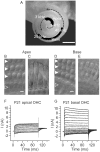BK channels mediate cholinergic inhibition of high frequency cochlear hair cells
- PMID: 21079807
- PMCID: PMC2973960
- DOI: 10.1371/journal.pone.0013836
BK channels mediate cholinergic inhibition of high frequency cochlear hair cells
Abstract
Background: Outer hair cells are the specialized sensory cells that empower the mammalian hearing organ, the cochlea, with its remarkable sensitivity and frequency selectivity. Sound-evoked receptor potentials in outer hair cells are shaped by both voltage-gated K(+) channels that control the membrane potential and also ligand-gated K(+) channels involved in the cholinergic efferent modulation of the membrane potential. The objectives of this study were to investigate the tonotopic contribution of BK channels to voltage- and ligand-gated currents in mature outer hair cells from the rat cochlea.
Methodology/principal: Findings In this work we used patch clamp electrophysiology and immunofluorescence in tonotopically defined segments of the rat cochlea to determine the contribution of BK channels to voltage- and ligand-gated currents in outer hair cells. Although voltage and ligand-gated currents have been investigated previously in hair cells from the rat cochlea, little is known about their tonotopic distribution or potential contribution to efferent inhibition. We found that apical (low frequency) outer hair cells had no BK channel immunoreactivity and little or no BK current. In marked contrast, basal (high frequency) outer hair cells had abundant BK channel immunoreactivity and BK currents contributed significantly to both voltage-gated and ACh-evoked K(+) currents.
Conclusions/significance: Our findings suggest that basal (high frequency) outer hair cells may employ an alternative mechanism of efferent inhibition mediated by BK channels instead of SK2 channels. Thus, efferent synapses may use different mechanisms of action both developmentally and tonotopically to support high frequency audition. High frequency audition has required various functional specializations of the mammalian cochlea, and as shown in our work, may include the utilization of BK channels at efferent synapses. This mechanism of efferent inhibition may be related to the unique acetylcholine receptors that have evolved in mammalian hair cells compared to those of other vertebrates.
Conflict of interest statement
Figures






References
-
- Dallos P, Harris D. Properties of auditory nerve responses in absence of outer hair cells. J Neurophysiol. 1978;41:365–383. - PubMed
-
- Ryan A, Dallos P. Effect of absence of cochlear outer hair cells on behavioural auditory threshold. Nature. 1975;253:44–46. - PubMed
-
- Dallos P, Cheatham MA. Cochlear hair cell function reflected in intracellular recordings in vivo. Soc Gen Physiol Ser. 1992;47:371–393. - PubMed
-
- Nakagawa T, Kakehata S, Akaike N, Komune S, Takasaka T, et al. Voltage-dependent channels in dissociated outer hair cells of the guinea pig. Eur Arch Otorhinolaryngol. 1994;251(Suppl 1):S57–60. - PubMed
Publication types
MeSH terms
Substances
Grants and funding
LinkOut - more resources
Full Text Sources

